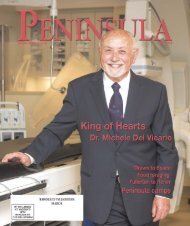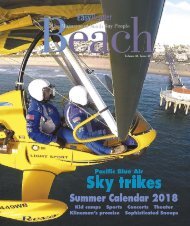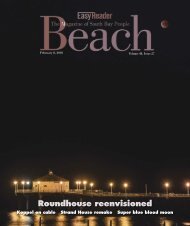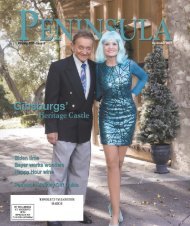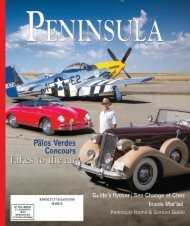Create successful ePaper yourself
Turn your PDF publications into a flip-book with our unique Google optimized e-Paper software.
12 • THE <strong>Reader</strong><br />
<strong>March</strong> <strong>2016</strong><br />
loCal hiStory<br />
The St. Francis Dam Disaster: 13 Things You Probably Don’t Know<br />
by John Boston<br />
Staff Writer<br />
Quiet San Francisquito Canyon in<br />
Saugus is infamous for being the site<br />
of the 11th-worst manmade disaster<br />
in American history. Just before midnight,<br />
on <strong>March</strong> 12, 1928, the St. Francis Dam<br />
burst, sending a nearly 200-foot tidal wave of<br />
water down the canyon. For 55 miles, the<br />
flood carved a watery path of destruction all<br />
the way to the Pacific Ocean and killed between<br />
500-to-600 people.<br />
This epic flood nearly bankrupted Newhall<br />
Land & Farming Co. It devastated the thinly<br />
populated Santa Clarita Valley, wiping out entire<br />
families, destroying farms and casting a<br />
pale of tragedy that would be felt for decades.<br />
It turned a beautiful canyon, lined with great<br />
trees, meadows, flowers and grassland into a<br />
nightmarish landscape. Family members<br />
noted the break probably crushed the soul of<br />
its builder, William Mulholland, who had<br />
green-lighted the dam’s soundness just 12<br />
hours earlier.<br />
Mulholland retired shortly after the disaster,<br />
went into seclusion and died a few years<br />
later, a broken man.<br />
After the 1906 San Francisco fire, which<br />
followed the epic earthquake, the St. Francis<br />
Dam is the worst disaster in California history.<br />
There are many stories about the dam,<br />
ill-fated (the dam was built at the convergence<br />
of three earthquake fault lines) even<br />
before the first shovel of dirt was removed.<br />
Here are 13 things you probably don’t know<br />
about our valley’s forever-dark chapter in<br />
American history…<br />
13) The day of the break, dam keeper Tony<br />
Harnischfeger had a home near the base of<br />
The disaster is heartbreaking, when you put young<br />
faces to it. Two of the first casualties were little girls<br />
Marjorie and Mazie Curtis, and their father,<br />
Lyman. The little boy, their 3-year-old brother<br />
Danny, managed to survive, with his mother, Lillian.<br />
PhoTo CoURTeSy oF <strong>SCV</strong> hiSToRiCAL SoCieTy.<br />
the monolith and called Mulholland that the<br />
dam was springing enormous leaks. The<br />
DWP employee was also the dam’s first victim.<br />
They found half his body several miles<br />
downstream. About two years later, they<br />
found the second (and lower) half of his body<br />
with his wallet and ID intact..<br />
12) Mulholland was fully exonerated in<br />
Mulholland, without any tests, oversight, calculations or widening the base, added an additional 13-feet to the<br />
height of the dam, making it 187-feet tall. Shortly after the disaster, the DWP blew up this monolith as a PR move.<br />
PhoTo CoURTeSy oF <strong>SCV</strong> hiSToRiCAL SoCieTy.<br />
1995 by geological engineer J. David Rogers<br />
68 years later. Rogers published that Mulholland<br />
didn’t have the technology to know<br />
the dam was built on ancient fault cracks.<br />
But, local newspaper reports noted that even<br />
before construction, many locals warned<br />
Mulholland the ground was unstable and<br />
L.A.’s chief engineer ignored them.<br />
11) Local mail carrier W.T. Stonecypher<br />
also warned Mulholland. Months earlier, the<br />
rural deliveryman noted that 500-feet of<br />
road was drastically sinking (about four feet)<br />
from the weight of the water and concrete.<br />
Stonecypher refused to continue that portion<br />
of his route and people had to come into<br />
town for their mail.<br />
10) Newhall’s Ed Adkins was in charge of<br />
collecting corpses. He delivered hundreds of<br />
dead bodies to various spots, including the<br />
Hap-a-Land Hall (where the Courthouse<br />
Building on Market St. is today). The hall was<br />
the <strong>SCV</strong>’s social center, where they held most<br />
big community parties, movies and dances.<br />
After serving as a morgue, it was never used<br />
as a social spot again. Adkins had the stomach<br />
for his job. He had been in China during<br />
the Boxer Rebellion and had witnessed hundreds<br />
of beheadings.<br />
9) Easily the most supernatural of all stories<br />
involves famed movie star Harry Carey.<br />
He had a huge ranch in the canyon and employed<br />
about 100 Navajos to run it. A few<br />
days before the dam burst, Carey was in New<br />
York City, starring in a Broadway play. The<br />
tribe’s medicine man called and reported he<br />
had a nightmare of impending and epic disaster<br />
and said he would be moving the entire<br />
village back to Arizona. They left and avoided<br />
certain death.<br />
8) Southern California Edison set up a<br />
work camp near Castaic by the Santa Clara<br />
River. Camping out in tents, many of the men<br />
drowned. But about one-third were saved<br />
when their tents acted as air pockets. Survivors<br />
were able to float to safety.<br />
7) Author Charles Outland noted that the<br />
City of Los Angeles settled all claims without<br />
much question. But, if you were a person of<br />
color, you received less money for your suffering<br />
and loss than white victims. Outland<br />
wrote “Man-Made Disasters” and was a boy<br />
in Santa Paula when the dam burst.<br />
6) One of the aspects of the disaster was<br />
that it changed a beautiful, scenic canyon<br />
with trees and meadows into a gutted valley.<br />
Gone were most of the shrubbery, trees and<br />
wildflowers and the topsoil to grow more.<br />
5) Several local survivors planted signs<br />
around the valley, reading: “Kill Mulholland.”<br />
4) Lifetime resident Bailey Haskell was a<br />
teen who rushed in the dark to help rescue<br />
victims. As a shiveringly cold dawn broke, he<br />
spotted a 12-year-old girl clutching to the<br />
higher branches of an oak. The flood had<br />
completed tore all her clothing away. Haskell<br />
got a ladder, climbed the tree, threw a blanket<br />
around her and carried her down to<br />
safety. He noted she was so embarrassed that<br />
for 50 years after, she never looked at him or<br />
acknowledged her rescuer’s presence.<br />
3) Superstar Wm. S. Hart was part of the<br />
rescue. He found the body of a little boy,<br />
about 6, near Piru and could never find the<br />
family. Hart arranged for the child to be<br />
buried in a cowboy outfit and be buried in<br />
the Ruiz family cemetery in San Francisquito.<br />
The unknown boy’s tombstone reads: “The<br />
Littlest Wrangler.”<br />
2) While it’s the Ruiz family cemetery, to<br />
this day it’s called the Chinese Graveyard.<br />
The SF Canyon resident Henry Ruiz would<br />
later grow to manhood and ironically work<br />
for the DWP. He lost eight members of his<br />
family in the flood and never talk about that<br />
night again.<br />
1) When 12 billion gallons of floodwaters<br />
reached the Pacific around dawn on <strong>March</strong><br />
13, Ventura fishermen reported a gruesome<br />
sight — an apocalyptic shark feeding frenzy<br />
on corpses — animal to human — washed<br />
out to sea and floating on the surface. R<br />
(Left) newhall’s dance hall and<br />
community center, the hap-a-<br />
Land hall, became a makeshift<br />
morgue. Before sunrise, volunteers<br />
were already setting up<br />
slats to stack bodies. PhoTo CoUR-<br />
TeSy oF <strong>SCV</strong> hiSToRiCAL SoCieTy.<br />
(Below) This is the last<br />
known photo of dam<br />
keeper Tony harnischfeger.<br />
he and his wife<br />
divorced in 1927 and he<br />
lived alone at the base of<br />
the dam. PhoTo CoURTeSy oF<br />
<strong>SCV</strong> hiSToRiCAL SoCieTy.




